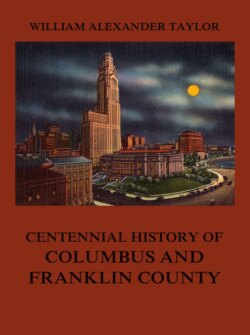Читать книгу Centennial History of Columbus and Franklin County - William Alexander Taylor - Страница 4
На сайте Литреса книга снята с продажи.
CHAPTER I. THE CAPITAL CITY OF OHIO.
ОглавлениеExplanatory Geographical Note.
The state of Ohio, in its entirety, lies between latitude 38 degrees 27 minutes and 41 degrees 57 minutes N. and longitude 80 degrees 34 minutes and 84 degrees 49 minutes W. The maximum length of the state east and west being two hundred and ten miles, and the maximum breadth from south to north one hundred and fifteen. The center of the originally surveyed square on which the capital buildings were erected is latitude 37 degrees 57 minutes, longitude 82 degrees 29 minutes, almost equidistant from the cities of Cleveland northeast, Toledo northwest, Cincinnati southwest and Marietta southeast, at an average maximum distance from the capital of one hundred and fifteen miles.
A line drawn through Columbus north and south and another east and west divides the state into four almost equal parts. The most distant points, and somewhat in excess of the one hundred and fifteen mile maximum, are at the corner of the state at the intersection of, the Pennsylvania line on the northeast and the intersection of the Ohio, Indiana and Michigan lines on the northwest.
Aside from these points, however, the one hundred and fifteen mile radius is dominant and inclusive, making the average railway and traction distance between the capital and the furthest state points within four hours of average schedule time, and those within the smaller radii from fifteen minutes to two hours and thirty minutes. These lines of travel extend regularly in all directions and following with remarkable fidelity the aboriginal and pioneer lines of travel, which coincidence will be adverted to hereafter at greater length.
The Founding of the City of Columbus.
The selection of the present site of the city of Columbus was purely political, speaking in contradistinction to the commercial idea and using the terms "political" and "commercial" in their broadest and best significance. There were and could be no commercial reasons for founding the city at the junction of the Scioto and the Olentangy rivers in the first decade of the nineteenth, however strong those reasons might be in the first decade of the twentieth century. Then it was practically an unbroken forest, marked here and there with puny settlements, for scores of miles in all directions from the present State House Park. Now it is a modern city standing like the hub of a wheel from which radiates lines of steam and electric roads, some of them main lines of commerce as well as transportation, in every direction, and so fixed naturally by the geographical location of the city as to bring the vast preponderance of the five million population within from three hours and thirty minutes, and in most cases in from two hours, down to thirty minutes' travel of the capitol building; albeit the state is two hundred and ten miles in length east and west, and two hundred and fifteen miles broad north and south.
The conditions existing a century ago fully explain why commercial ideas did not weigh in the selection of the site, but on the contrary throbbed with political reasons in favor of it. The capital of the Northwest Territory, organized by the ordinance of 1787, was, in a sense, a peripatetic affair and was located at three different points—Marietta, Cincinnati and Chillicothe. Originally and nominally at Marietta, tentatively at Cincinnati and with a degree of permanence at Chillicothe. The territory was a vast, unpopulated empire extending from the Ohio valley north and northwest to Lake Superior and along the great chain of lakes eastward to the northwest boundary of Pennsylvania, westward to the Mississippi and with the Ohio river its eastern and southern boundary.
